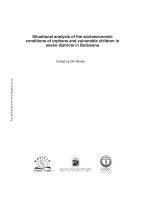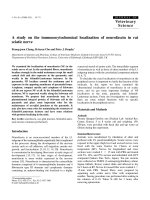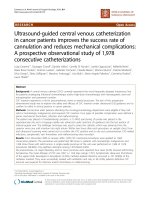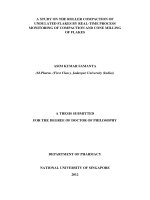A STUDY IN THE SELECTIVE POLYMORPHISM OF a AND b GLYCINE IN PURE AND MIXED SOLVENT
Bạn đang xem bản rút gọn của tài liệu. Xem và tải ngay bản đầy đủ của tài liệu tại đây (4.54 MB, 170 trang )
A STUDY IN THE SELECTIVE POLYMORPHISM OF - AND -
GLYCINE IN PURE AND MIXED SOLVENT
ADAM IDU JION
(B. Eng. & MSc., National University of Singapore)
A THESIS SUBMITTED
FOR THE DEGREE OF DOCTOR OF PHILOSOPHY
DEPARTMENT OF CHEMICAL AND BIOMOLECULAR ENGINEERING
NATIONAL UNIVERSITY OF SINGAPORE
2013
1
DECLARATION
I hereby declare that this thesis is my original work and it has been written by me in its
entirety. I have duly acknowledged all the sources of information which have been used in
the thesis.
This thesis has also not been submitted for any degree in any university previously.
Adam Idu Jion
20
th
April 2014
2
ACKNOWLEDGEMENTS
I enjoy doing research, and see myself as an amateur scientist. Thus it brings me great
joy to be affiliated with professionals from the Department of Chemical and Biomolecular
Engineering at the National University of Singapore. In particular, I am indebted to Prof. Raj
Rajagopalan and Dr. Sivashangari for introducing to me the power of molecular dynamics
simulation, and how it could be used to tackle open problems such as glycine polymorphism.
I would also like to thank Prof. Srini M.P. for his unwavering support. I appreciate their time
and supervision, and wish them success in their future endeavours.
3
Contents
DECLARATION 1
ACKNOWLEDGEMENTS 2
SUMMARY 7
NOMENCLATURE 13
1 Introduction 19
1.1 Approach Taken and Tools Created 22
1.2 Selection of Glycine as a Model to Study Crystal Polymorphism 24
1.3 Structure of the Thesis 25
2 Literature Review 26
2.1 Theories of Crystal Growth 26
2.2 Effect of Solvent on Crystal Growth 28
2.3 Lack of Computational Tools for the Study of Crystal Growth 31
2.3.1 Use of Kinetic Monte Carlo Methods 32
2.3.2 Use of Interaction Energies 34
2.3.3 Use of Statistical Mechanics 36
2.4 Glycine Polymorphism 39
2.4.1 Link Mechanism and Controversy 41
2.5 Lack of Algorithms to Investigate Glycine Molecules 43
3 Aims and Objectives 47
4 Tools Developed & Techniques Used 49
4.1 Algorithms for detecting self-assembly of molecules in solution 49
4.1.1 Direct search for self-assembly 51
4.1.2 Unsupervised search for self-assembly 56
4.2 Mathematical strings and the free energy in n-dimensional space 60
4
4.2.1 Modified Version of the Finite-Temperature String Method 61
4.2.2 Method to calculate the generalized activation energy 65
4.2.3 Method to calculate the fraction of growth-units at the interface 67
5 Force-fields and Partial Charges 69
5.1 Molecular dynamics simulation 69
5.2 Force-fields for glycine simulation 70
5.3 Partial charges 71
5.4 Validation of force-fields for bulk solution 75
5.5 Summary of force-fields for bulk water simulation 78
5.6 Extension of force-fields to binary mixtures and interfaces 78
6 Existence of Cyclic-Dimers 82
6.1 Controversy over existence of cyclic-dimers 82
6.2 Mathematical definition of a cyclic-dimer 83
6.3 Results and discussion of molecular dynamics simulation in bulk water 84
6.3.1 Existence of cyclic-dimers in bulk solution 84
6.3.2 Stability of cyclic-dimers 85
6.3.3 Cyclic-dimers vs. Open dimers 89
6.4 Comparison of simulation in bulk water and mixed solvent 91
6.5 Results & discussion of molecular dynamics simulation at the interface 95
6.5.1 Density profile at the interface 95
6.5.2 Absence of bilayer mechanism 96
6.5.3 Existence of cyclic-dimers at the interface 96
7 Growth Units & Interfacial Analysis 99
7.1 Orientation configuration 99
7.2 Gap-statistics and the types of growth units at the interface 100
7.2.1 Results and discussion of the Gap-Statistics 101
7.3 Interfacial Analysis 105
5
7.3.1 Energy barrier for glycine crystal growth 107
7.4 Finite Temperature String Method 108
7.5 Finite Temperature String Method and Interfacial Analysis 110
7.6 Finite Temperature String Method and Activation energies 112
7.7 Results and discussion of interfacial analysis 113
7.8 Absence of surface phenomena 120
7.9 Error Analysis 125
8 Concluding Remarks 129
8.1 Classical Nucleation Theory 129
8.2 Evidence of nucleation kinetics controlling - and - polymorphism 131
8.3 The problem with studying nucleation via molecular dynamics 133
8.4 Outline of approach to study the nucleus 134
6
List of Appendices
Appendix A.1: The Gillespie algorithm 143
Appendix A.2: Interfacial Analysis 144
Appendix A.3: Simulation in Bulk Solution 148
Appendix A.4: Simulation at the Interface 149
Appendix A.5: Further elaboration on equations 159
Appendix A.6: Calculating growth rates and predicting crystal morphology 160
Appendix A.7: Validation of our code for the Finite Temperature String Method 163
Appendix A.8: A Review of Physical Experiments ………….…………………………………………… 167
7
SUMMARY
The molecular mechanism of crystal growth is an essential step towards the study of
crystal polymorphism (i.e. crystalline phases of the same composition but different molecular
packing). Since the shape of a crystal influences its physical and chemical properties (e.g.
dissolution rate, and hence bioavailability), polymorph prediction is of prime interest and
importance to the pharmaceutical industry. However, it is difficult to predict if one
polymorph will nucleate or grow faster than another when grown in the same liquid, even
with knowledge of their internal structures and thermodynamic properties. As such,
polymorph formation and discovery often depend on the random manipulation of external
factors such as temperature, solvent, level of supersaturation, and solution purity. The exact
molecular mechanism played by these external factors at the crystal interface, for example, is
not fully understood. Thus crystal growth in solutions is an active area of research.
In recent years, there has been a proliferation of experimental techniques to study
crystal growth in solutions at the molecular level. However, there has been a lack of
complementary computational approaches that would allow one to interpret experimental
data and offer guidance for further experimentation. Whilst purely atomistic simulations can
in principle be applied for such purposes, they are extremely time consuming and demand
large computational resources. In view of this, we use a multi-scale approach that combines
molecular dynamics simulation with thermodynamic analysis, and at the same time, we
develop new algorithms and computational techniques to study crystal growth in solutions.
Such an approach will greatly facilitate investigations at the atomic scale of resolution for
bulk solutions and at crystal-solution interfaces. In particular, it will enable the study of pure
and mixed solvents on crystal polymorphism. Our technique is computationally cheap,
8
reliable and robust. It can extend the results of desktop computer simulations to the
thermodynamic limit. This, we hope, will convince computer simulationist to incorporate our
technique and algorithms into their arsenal of tools.
In the present work, we choose α- and -glycine due to its simple structure, and since
glycine is an excipient for proteins with a large body of experimental data. Also, there has
been an intense debate behind the mechanism for α- and -glycine crystal growth (i.e.
monolayer vs. bilayer growth) and their associated growth units (i.e. monomer vs. cyclic
dimers). We hope to contribute to this debate using our newly developed computational
technique. We show that although cyclic dimers exist in solution, they are too unstable to
constitute a growth-unit. We also show that both α- and -glycine crystal grow via a
monolayer mechanism with single monomers acting as growth units. Hence, we hypothesize
that the manifestation of α- and -glycine polymorphs in pure water and alcoholic solutions
respectively, are due to the kinetics of nucleation and not due to the kinetics of crystal
growth.
Keywords: Molecular dynamics, α- and
-
glycine polymorphism, Cyclic-dimers, Interface
Analysis, Crystal Morphology, Gap-Statistics, Finite-Temperature String Method
9
List of Tables
Table 4-1: Pseudo-code for finding the number of clusters in a computer simulation 54
Table 5-1: Partial Charges 72
Table 5-2: Group charges and lattice energies. 75
Table 5-3: Dielectric in the bulk and at the interface 80
Table 5-4: RESP charges for glycine zwitterions in the bulk and at the interface 81
Table 7-1: Types of clusters present at the (010) interface 104
Table 7-2: Fraction of molecules at the (010) interface that will eventually dock. 114
Table 7-3: Generalized activation energies for monomeric / monolayer growth 115
Table 7-4: Activation energies for monomeric / monolayer growth at the (010) surface. 116
Table 7-5: Values for calculating the growth rates at the (010) surface 118
Table 7-6: Values for calculating the growth rates at the (010) surface in mixed solvent 120
Table 7-7: Number of particles sampled in the bulk and at the interface. 122
Table 7-8: Comparison of values obtained with the thermodynamic limit. 128
10
List of Figures
Figure 1-1: Different types of approach to study polymorphism. 20
Figure 1-2: Multi-scale approach for the study of crystal growth in solutions. 23
Figure 1-3: Glycine Polymorphism. 24
Figure 2-1: Surface structure of a glowing crystal . 26
Figure 2-2: Development of a growth spiral from a screw dislocation 27
Figure 2-3: Important diffusion processes affecting crystal growth . 29
Figure 2-4: Free energy barriers to be overcome during crystal growth 30
Figure 2-5: Scheme for the relay mechanism 30
Figure 2-6: The use of microscopy. 31
Figure 2-7: Schematic illustration of the Kossel model 32
Figure 2-8: Solvent-crystal interaction energies for glycine crystal slab. 35
Figure 2-9: Gibbs free energy diagram for urea crystals grown in solution 37
Figure 2-10: Free energy landscape with two spatial dimensions. 38
Figure 2-11: Glycine Zwitterion. 39
Figure 2-12: Packing arrangements of the glycine polymorphs 40
Figure 2-13: Glycine cyclic-dimer. . 41
Figure 2-14: Configuration of glycine molecules with correct dimer fraction 45
Figure 2-15: Configuration of glycine molecules with incorrect dimer fraction. 46
Figure 2-16: Configuration of glycine molecules with incorrect dimer fraction 46
Figure 4-1: Amphiphilic molecules can self-assemble 50
Figure 4-2: Self-assembly of glycine molecules. 50
Figure 4-3: Using the R
sgl
linkage 52
Figure 4-4: The direct search algorithm. 55
Figure 4-5: An example of clustering 57
11
Figure 4-6: The unsupervised search will correctly cluster and identify the structure 57
Figure 4-7: Example plots of the gap statistics. 59
Figure 4-8: Hypothetical two-dimensional energy landscape 62
Figure 4-9: Each string will undergo repeated iteration and reparameterization. 63
Figure 4-10: Projection of energy phase space
onto a 2-dimensional plane. 64
Figure 4-11: Plot of Gi vs. s for a hypothetical string
i
. 66
Figure 5-1: Fraction of cyclic dimers as a function of glycine concentration 76
Figure 5-2: Comparison between experimental self-diffusivity and simulation values. 77
Figure 5-3 :
2
is the electric field 79
Figure 6-1: Glycine cyclic-dimer. 82
Figure 6-2: Fraction of cyclic-dimers as a function of glycine concentration 84
Figure 6-3: Hydrogen-bond correlation function for glycine zwitterions 86
Figure 6-4: The semi-log plot of the hydrogen-bond correlation function 87
Figure 6-5: Mean hydrogen-bond lifetime 87
Figure 6-6: Cyclic dimer lifetimes 88
Figure 6-7: Fraction of glycine cyclic-dimers as a function of supersaturation 92
Figure 6-8: Fraction of glycine monomers as a function of supersaturation. 92
Figure 6-9: H-bond lifetimes as a function of glycine concentration. 93
Figure 6-10: Cyclic-dimer lifetime as a function of glycine concentration. 94
Figure 6-11: Density profile of an -and -glycine crystal slab. 95
Figure 6-12: Cyclic-dimer fraction for glycine zwitterions at an interface 97
Figure 6-13: Monomeric fraction for glycine zwitterions at an interface 98
Figure 7-1: Dipole vectors. 99
Figure 7-2: Gap-Statistics for glycine 102
Figure 7-3: A sample of 500 observations taken at the interface for the -polymorph. 104
Figure 7-4: Schematic interface between crystal and bulk solution. 105
12
Figure 7-5: Arrangement of the glycine molecules in the α-polymorph………………………………………. 106
Figure 7-6: Gibbs free energy distribution for molecules at the (010) interface. 108
Figure 7-7: An example of a single string
i
. 110
Figure 7-8:
i
G
is the parameterization of string
i
. 112
Figure 7-9: Mean square displacement of glycine molecules for the -polymorph 123
Figure 7-10: Mean square displacement of glycine molecules for the -polymorph 124
Figure 7-11: Snapshot at 100 ns for the -polymorph crystal slab 124
Figure 7-12: Computer experiments were conducted for crystal slabs of increasing size. 126
Figure 7-13: The thermodynamic limit. 127
Figure 8-1: Formation of a nucleus is a competition 131
Figure 8-2: Illustration of a glycine nucleus/drop. 135
13
NOMENCLATURE
ABBREVIATIONS
API Active Pharmaceutical Ingredient
MD Molecular Dynamics
MI Morphologically Important
BFDH Bravais-Friedel-Donnay-Harker rule
BCF Burton-Cabrera-Frank theory
PBC Periodic Bond Chain analysis
ISA Interface Structure Analysis
SCF Self-Consistent Field
SAM Self-Assembled Monolayer
AFM Atomic Force Microscopy
SPM Scanning Probe Microscopy
SPC/E Extended Simple Point Charge model
BLYP Becke exchange plus Lee-Yang-Parr correlation functional
DNP Double-Numerical plus d- and p-Polarization basis set
ESP Electrostatic Potential
RESP Restrained Electrostatic Potential
14
TIP Transferable Intermolecular Potential Functions
NPT Fixed pressure P, temperature T, and number of atoms N ensemble
NVT Fixed volume V, temperature T, and number of atoms N ensemble
MSD Mean-Squared Displacement
DZP Double-Zeta plus Polarization
SYMBOLS
att
E
attachment energy (kJ/mol)
hkl
d
interplanar distance (m)
hkl
R
growth rate (m/sec)
*
hkl
C
surface scaling factor
step
V
step speed (m/sec)
hkl
width of the step (m)
kink
hkl
kink density
()A hkl
X
concentration of interfacial solution molecules
B
k
the Boltzmann constant (J/K)
T
temperature (K)
()hkl
G
activation free energy (KJ)
15
()
eff
A hkl
X
effective growth units concentration
*
kink
G
desolvation activation energy (KJ)
step
hkl
average step energy (KJ/mol)
c
r
radius of the two-dimensional nucleus
molecular volume (m
3
/mol)
supersaturation
diss
hkl
H
3D local dissolution enthalpy (kJ/mol)
hkl
n
coordination number
hkl
crystallographic orientation factor
slice
hkl
E
slice energy per molecule (KJ/mol)
cr
E
lattice energy per molecule (KJ/mol)
diss
H
enthalpy of dissolution (KJ/mol)
A
X
concentration of solute in the bulk solution
2
R
the rate of transformation from F
2
to F
1
growth unit
2
1
R
the rate of transformation from F
1
to F
2
growth unit
1 S
R
the rate of transformation from F
1
to S
1
growth unit
1
1
S
R
the rate of transformation from S
1
to F
1
growth unit
16
2 S
R
the rate of transformation from F
2
to S
1
growth unit
1
v
frequency of vibration for F
1
units
2
v
frequency of vibration for F
2
units
2
v
frequency of vibration for S
1
units
1
chemical potential difference between F
1
and F
2
units
s
chemical potential difference between S
1
and F
1
units
1
F
chemical potential for F
1
units
2
F
chemical potential for F
2
units
1
S
chemical potential for S
1
units
fraction of effective growth units
()P
the probability of finding an adsorbed growth unit in state τ
()
effectiveness factor
()p
the probability density function
CC
the orientations of the C
α
→C dipole vector with reference to the surface normal
(degree)
CN
the orientations of the C
α
→N dipole vector with reference to the surface normal
(degree)
17
CC
the azimuthal angle of the C
α
→C dipole vector with reference to the surface
normal (degree)
total
E
the potential energy function (KJ/mol)
b
K
the force constant for bond
K
the force constant for bond angle
b
bond length (m)
eq
b
equilibrium bond length (m)
bond angle (degree)
eq
equilibrium bond angle (degree)
n
V
force constant
dihedral angle (degree)
phase angle (degree)
ij
A
van der Waals term
ij
B
london dispersion term
,ij
partial charges
dielectric constant
()Dc
the self-diffusivity (cm
2
/sec)
18
2
( ) (0)r t r
the ensemble averaged mean-squared displacement
()rt
position of the molecule at time t (m)
sub
H
enthalpy of sublimation (KJ/mol)
pr
U
proton transfer energy (KJ/mol)
,,
x y z
D D D
diffusion coefficients in x, y and z directions (cm
2
/sec)
xz
D
diffusion coefficients in xz directions (cm
2
/sec)
rel
hkl
R
relative growth rate
19
1 Introduction
Polymorphism is the ability of a crystal to exhibit multiple habit, form or morphology.
The importance of polymorphism is underscored by efforts in the chemical and
pharmaceutical industries where polymorph discovery and characterization are vital in
determining the viability of both processes and products. Certain crystal polymorphs are
disliked in commercial crystals because they give the crystalline mass a poor appearance;
others make the products prone to caking [1], induce poor flow characteristics or give rise to
difficulties in the handling or packaging of material. Polymorphism of a crystalline material
can also affect its solid-state properties. The dissolution rate and bioavailability of potential
drugs, for example, are dependent on its final crystal habit [2]. In most industrial
crystallization, some form of modification procedure is necessary to control the type of
crystal polymorphs produced. Hence polymorph prediction and engineering is a very
important field of research.
The control of polymorphism, however, remains a central challenge. It has been well
known for centuries that the final habits of crystals depend on its solution environment.
However, the exact role played by solvent/mixed solvents in directing the type of crystal
polymorphs is not well understood. There are two dominant ideas regarding the mechanism
which affects polymorphism [3] – nucleation and crystal growth. The nucleation hypothesis
posits that mature crystals grow from crystal nuclei, and that these nuclei already have the
structures which resemble the mature crystalline form. That is, the final dominantly-observed
crystal morphology depends on its nuclei achieving a critical size where the energetically
favourable volume energy outweighs the energetically unfavourable surface energy (see
Chapter 8 for more details). The crystal growth hypothesis posits that growth rates of the
20
crystals after nucleation determines the final dominantly-observed morphology. That is,
although there may be nuclei belonging to different polymorphs at the initial stages of
crystallization, only the fastest growing polymorph will eventually dominate. In this thesis,
we will explore the crystal growth hypothesis.
In the crystal growth hypothesis, solvent plays an important role at the crystal
interface, and has a strong influence on crystal shape. However, it is not clear whether the
solvent–solute interactions at an interface enhance or inhibit crystal growth [4]. Favourable
interactions between solute and solvent on a crystal face, for example, reduce interfacial
tension and consequently enhance crystal growth [5]. However, the preferential adsorption of
solvent molecules on a crystal face may delay the removal of the solvation layer and the
deposition of the next layer, and thus inhibit crystal growth [6]. The role of mixed solvent is
also poorly understood. In general, cosolvents work by reducing the solubility of the solutes,
and hence increasing the supersaturation of the solution [7]. However, it is not fully known at
the molecular level, how cosolvents enhance/inhibit growth rates or how they behave at the
crystal/solvent interface [8].
Figure 1-1: Different types of approach to study polymorphism.
21
The study of crystal polymorphism has been conducted by a multitude of physical
experiments. Starting off as simple naked-eye observations, polymorphism experiments have
evolved to using more sophisticated instruments [9] involving microscopy and x-rays (Fig.
1.1). As a result, detailed rule-of-the-thumb knowledge and heuristics are available on the
relationship between crystal growth and parameters such as temperature, supersaturation and
impurities. However, machine limitations still exist – physical experiments cannot study
surfaces of rapidly growing crystals, and cannot investigate the time evolution of such
surfaces [10]. Although there are lots of theoretical models [11, 12] predicting crystal growth,
and compensating for experimental deficiency, they often underplay the role of solvent, or
exclude them entirely. As such, crystal growth remains more art than science. Hence, it is
very useful to complement experimental studies and theoretical work with molecular and
atomic level simulations.
Computer simulations (i.e. molecular dynamics and Monte Carlo simulations) enable
brute-force computing power to be coupled with visual inspection, transforming the computer
into a powerful ‘microscope’. Thus it allows crystal growth experiments to be conducted at
an atomic scale of resolution, providing insights that cannot yet be obtained by physical
experimentation. However, computer simulations in general suffer from timescale limitations
and finite-size effects. This is especially true when studying surfaces such as those
encountered in crystal growth experiments. Hence, various strategies must be employed to
scale up the simulation towards the thermodynamic limit. Also, algorithms have to be
implemented to parse the data, and make sense of the information.
The aim of the present work is to introduce new computational tools and algorithms to
study the surface of growing crystals, and address some of the important issues related to
22
crystal polymorphism from solution. In particular, computer simulations will be used to
explore the effect of different solvents on growth units (i.e. monomers vs. dimers) and
eventual crystal polymorph. In Section 1.1, the approach for studying crystal surfaces as well
as the computational tools created and utilized will be explained. This is followed by the
selection of system for crystal growth in Section 1.2. Finally, the structure of the thesis is
described in Section 1.3.
1.1 Approach Taken and Tools Created
We choose to study crystal growth in solution via a multi-scale approach (Fig. 1.2)
that combines ab initio quantum mechanical calculations with molecular dynamics and
thermodynamic analysis. In particular, we use the GAUSSIAN [13] software together with
GROMACS and AMBER molecular dynamics packages [14, 15] for computer simulations,
and employ statistical mechanics [16] to scale up the simulation to the thermodynamic limit
[17, 18]. In the process of studying the bulk glycine solution and the crystal-solution interface
for a model glycine crystal slab [19, 20], we create several novel computational tools,
namely;
Algorithms that search directly for the presence of cyclic-dimers and higher-
order n-mers in bulk solution and at the interface
Algorithms that carry an unsupervised search [21] for clusters/aggregates,
growth-units or any other non-random structures in bulk solution and at the
interface
Algorithms that make use of mathematical ‘strings’ [22] to calculate the
energy barrier for crystallization in n-dimensional space
23
Algorithms that can calculate the fraction of molecules at the crystal-solution
interface that will eventually dock onto the bulk crystal
By making use of the computational tools and algorithms above, and by conducting long-time
molecular dynamics simulation via means of GPU-computing [23], we can examine the types
of growth units present in the bulk phase and at the interface. We also hope to contribute to
the debate on the growth-units for α and -glycine (i.e. monomer vs. cyclic-dimer) [24-27],
their growth mechanism (i.e. monolayer vs. bilayer) [28, 29], and hence their eventual
morphology (i.e. bypyramidal vs. needle-like) [30, 31].
Figure 1-2: Multi-scale approach for the study of crystal growth in solutions. Ab initio
calculations are conducted to compute the partial charges of the solute molecules. These are
then fed into a molecular dynamics simulation where statistical mechanics will be used to
scale up the simulation toward the thermodynamic limit.
24
1.2 Selection of Glycine as a Model to Study Crystal Polymorphism
Amino acids are the building blocks of proteins. They can be used as a first
approximation to model the thermodynamic behaviour of proteins in solution. Glycine
(H
2
NCH
2
COOH) is an amino acid that crystallizes in the α-polymorph form in pure aqueous
solution and in the -polymorph form in alcoholic solution (Fig. 1.2). Glycine adopts a
zwitterionic form (
+
H
3
NCH
2
COO
-
) in the aqueous and crystalline state [32]. We choose
glycine as the model compound for our study because
it has a simple molecular structure
it is used as an excipient in proteins and pharmaceutical reagents
the H-bonding found in its crystal structure is similar to those found in protein crystal
the pro-chiral property of its crystal structure gives it enantio-selectivity to chiral
additives
it has a large body of experimental data
(a) (b)
Figure 1-3 Glycine Polymorphism (a) α-polymorph is bypyramidal, (b) -polymorph is
needle-like. Reproduced from [33] and [34] respectively.









